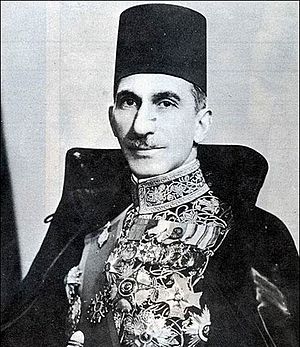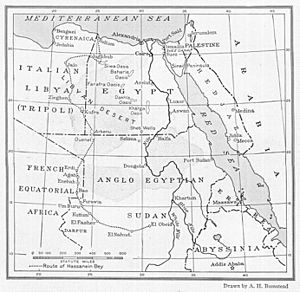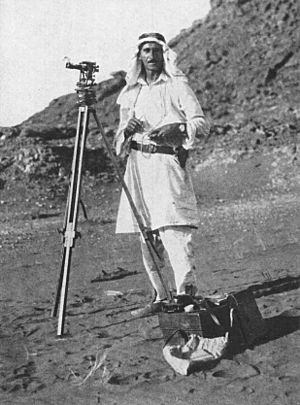Ahmed Hassanein facts for kids
Ahmed Hassanein Pasha (born October 31, 1889 – died February 19, 1946) was a famous Egyptian. He worked closely with the king, served as a diplomat, and was a great explorer. He also represented Egypt in the 1924 Summer Olympics as a fencer. Ahmed Hassanein was the teacher and chief assistant to King Farouk of Egypt.
Contents
Early Life and Education
Ahmed Hassanein was born in 1889. His father was a professor at Al-Azhar University. His grandfather was the last admiral of the Egyptian navy. Ahmed Hassanein studied at Balliol College, which is part of Oxford University in England.
Royal Tutor
King Fuad I, who was King Farouk's father, chose Ahmed Hassanein to be his son's tutor. When Prince Farouk was a teenager studying in London, Hassanein taught him. King Fuad spoke Turkish, but thanks to Hassanein, Prince Farouk learned to speak Arabic very well.
Amazing Desert Expeditions
Exploring the Libyan Desert
Ahmed Hassanein was a brave geographic explorer. In 1923, he went on an expedition across the vast Libyan Desert. This area was protected by a group called the Senussis.
In December 1922, Hassanein started a new scientific journey from Sallum. He carefully recorded directions and distances. He also took many photos and collected samples. He wrote a detailed journal about his experiences. He learned a lot about the traditions of the people he met.
Discovering Lost Oases
During his expedition, Ahmed Hassanein corrected the location of Kufra on maps. The most exciting part was when he discovered new water sources. These were called the "Lost Oases" of Jebel Uweinat and Jebel Arkenu. These discoveries opened up new routes across the Sahara Desert. He also took important photographs of ancient rock art.
Sharing His Discoveries
In September 1924, Ahmed Hassanein's report was published in the famous National Geographic Magazine. It included 47 photos and a map. The next year, his book, The Lost Oases, was published. It was later translated into Arabic and German.
Ahmed Hassanein's work was very important. He created an accurate map of a previously unknown region. He wrote about the history and traditions of the Senussis. He also collected geological samples and took thousands of photos. For his achievements, he received the title of Bey. He also won the prestigious Founder's Gold Medal from the British Royal Geographical Society in 1924.
Olympic Fencer
Ahmed Hassanein was also a talented athlete. He competed for Egypt in fencing at the 1920 and 1924 Summer Olympics. He participated in both the foil and épée competitions.
Images for kids





